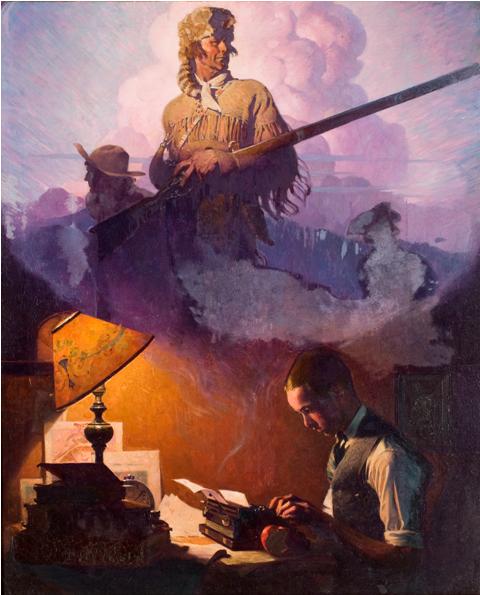
Norman Rockwell, "---And Daniel Boone Comes to Life on the Underwood Portable"; 1923, oil on canvas; Collection of Steven Spielberg; courtesy Smithsonian American Art Museum
Last week, the latest special exhibit opened up at the Smithsonian American Art Museum. “Telling Stories: Norman Rockwell from the Collections of George Lucas and Steven Spielberg” showcases 57 major Rockwell paintings and drawings from the private collections of two of Hollywood’s most influential modern moviemakers. The exhibition runs through January 2, 2011.
The exhibition – only being shown here in DC – is the first to plumb the depths of the connections between Rockwell’s images of American life and the movies. Between Rockwell’s work and the movies of Lucas and Spielberg, the themes of patriotism, small-town values, children growing up, unlikely heroes, imaginations, and life’s ironies are portrayed between canvas and film. “Ultimately, looking at Rockwell in terms of the movies opens a whole new way of understanding his work for the public,” said senior curator and exhibition organizer Virginia Mecklenburg, “but also for scholars interested in American popular and visual culture in the middle of the 20th century.”
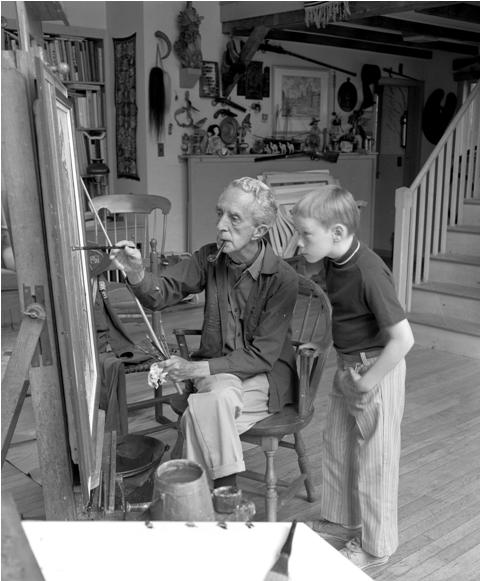
Norman Rockwell in his studio with model Hank Bergmans examining the painting "Can’t Wait," about 1970, Norman Rockwell Museum, Licensed by Norman Rockwell Licensing, Niles IL. Courtesy Smithsonian American Art Museum
“If I hadn’t become a painter, I would have like to have been a movie director,” Rockwell is known to have said. The painter visited Hollywood frequently in the 1930s and 40s, often designing posters for several studios and becoming immersed in the movie industry’s culture. His experiences there showed in his painting process, often going to great lengths to stage his pictures, laboring over costumes for each figure and the individual props to add to the story for the viewer to grasp. Rockwell was known for drafting multiple sketches to get composition and other details exactly right before executing the final work.
The exhibit features several Rockwell pieces, including “The Connoisseur” and “The Jury,” two particular pieces Mecklenburg is proud to have as part of the exhibit. “‘The Connoisseur’ is a scene we might see in art in museums anywhere in the country, but as a painting it has a universal message,” she said when I asked her about it. “It’s a metaphor for facing the future—something we all experience, especially as we get older and try to figure out what our own futures will be like. It’s a lot like the painting of the scared little boy peering over the end of the 20-foot diving board. It’s about people and the challenges we face in our lives.”
Bringing this exhibition exclusively to DC was a thrill for Mecklenburg. Inspired by both private collections, she felt that the public would see Rockwell in a new and deeper light. “Lucas and Spielberg have made movies that have to do with many of the same ideas as in Rockwell’s works, so they feel like kindred spirits in that sense. They also described Rockwell as a ‘cinematic’ artist, who told his stories in a single frame and made every element and detail a part of the story.”
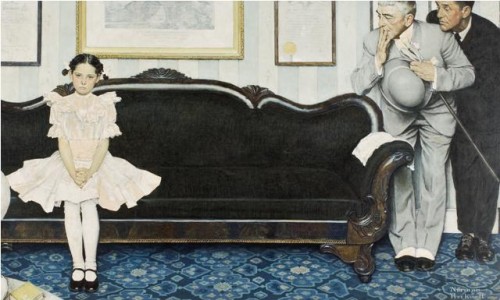
Norman Rockwell, "Let Nothing You Dismay"; 1941, oil on canvas; Collection of Steven Spielberg; Licensed by Norman Rockwell Licensing, Niles IL; courtesy Smithsonian American Art Museum
Such detail can be seen in “The Jury,” which tells a complex story within the static image. “At first, it seems like a first salvo in the women’s movement. It shows a determined young woman sitting at the end of a table surrounded by men who are clearly pressuring her about something,” said the senior curator. “A sign over the door says Jury Room, so we can figure out what’s going on. Like so many other pictures, it’s amusing – but it came out in 1959, when three states still prohibited women from serving on juries. So it’s also about women’s rights in American society in the late 1950s.” The movie connection with the piece is also strong – “The Jury” was the cover for the Saturday Evening Post less than two years after 12 Angry Men released, the Henry Fonda film about a hardcore jury and battle stereotypes and misconceptions. “It tells us a lot about Rockwell’s attention to what was going on in American culture and the way he often connected his pictures with themes and ideas that everyone saw at the movies,” said Mecklenburg.
Wandering the exhibition, one is hard-pressed to not get lost into personal memories and thoughts while gazing at Rockwell’s artistry. Mecklenburg explained her fondness for “Back to Civvies,” another recognizable work by the artist. “It speaks to me on a deeply personal level because it makes me think of my father, who was a bomber pilot during World War II,” she recounted. “He never talked about his war experience, so I always wondered how he felt about it, especially after seeing movies like Spielberg’s Saving Private Ryan and the Band of Brothers series. And I also wondered what it all meant for my mother for him to be away for so long.” The parallel to today’s world events isn’t lost on her, either. “These are the same things that matter now with men and women serving in Iraq and Afghanistan,” she continued. “So although the painting is amusing on the surface, the idea of leaving home in the service of one’s country is still very much with us today.”
When viewing the collection, it isn’t hard to realize that for Rockwell, it was indeed all about the story. George Lucas commented in a 2008 interview with Laurent Bouzereau that “[s]torytelling was very important with Norman Rockwell because every single picture he did told a specific story. Each one shows either the middle or the end of a story and you can already see the beginning even though it’s not there. You can see all the missing parts because he used one frame that tells everything you need to know. In filmmaking we strive for that. We strive to find images that convey a lot of information visually without having to spend a lot of time explaining them. And Norman Rockwell was a master at that.”
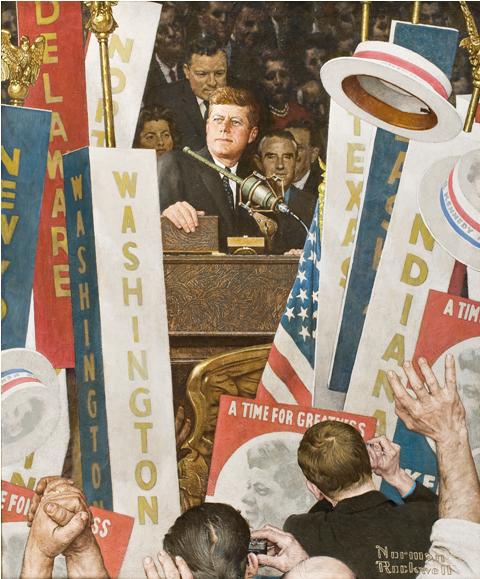
Norman Rockwell, "A Time for Greatness"; 1964, oil on canvas; Collection of George Lucas; Licensed by Norman Rockwell Licensing, Niles, IL; courtesy Smithsonian American Art Museum
Mecklenburg hopes visitors leave the museum with a better sense of Rockwell’s art, including the amusing whimsy of his Saturday Evening Post covers and sketches. “The show includes a lot of very funny pictures, so I hope people will have a great time talking about the way the pictures connect with their own lives and families,” she commented. “I also hope people will realize that Rockwell was a sophisticated man who was incredibly tuned in to what was going on in the world. Many of his pictures made it easier to adjust to changes in our own lives as well as in society as a whole because they made us laugh.”
In addition to the exhibition of various pieces, the Smithsonian American Art Museum is also tying in several educational components to enhance the experience for teachers and students, with an online and print curriculum guide and a teaching workshop program developed in conjunction with the National Archives and the National Council on the Social Studies. But even more fascinating is the depth of auxiliary events the Smithsonian is conducting to help further deepen the exhibition’s impact and depth.
A concert by the Washington Symphonic Brass on July 18 will perform music by John Williams and his scores from Spielberg and Lucas films in the Kogod Courtyard. Also planned is a family day on July 24 to celebrate the Boy Scouts of America’s 100th anniversary and a talk and book signing by Ron Schick, author of Norman Rockwell: Behind the Camera on August 5. The museum plans to present a series of classic films and movies during the run of the exhibition; for the summer, visitors can attend Spielberg’s Saving Private Ryan (1998) on July 22 and Frank Capra’s State of the Union (1948) on August 12. Showtimes and other information can be found on the museum’s website.
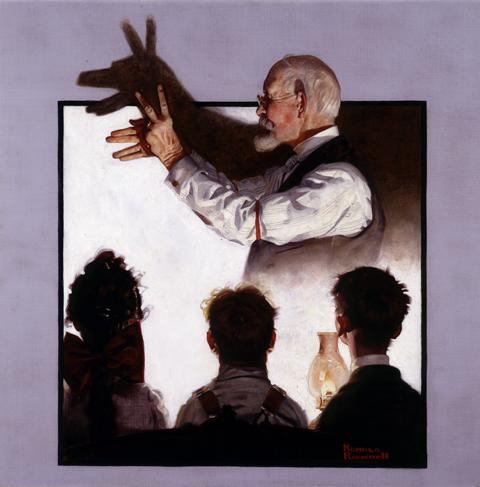
Norman Rockwell, "Shadow Artist"; 1920, oil on canvas; Collection of George Lucas; courtesy Smithsonian American Art Museum
For the more hands-on crowd, a Rockwell activity cart is located in the museum’s Kogod Courtyard, filled with props for visitors to stage and photograph their own Rockwell scene in front of a specially designed backdrop. Visitors are encouraged to add their photos to the museum’s Being Norman Rockwell Flickr group. The cart will be available a selected times which can be checked online. Also online is a podcast with commentary on the exhibit by the senior curator, interviews with both Lucas and Spielberg, and a slideshow of all 57 works displayed in the exhibit. “I would urge everyone to watch the 12-minute film running in the gallery in which Lucas and Spielberg talk about Rockwell and why he and his work count for them,” said Mecklenburg, highlighting one of the exhibition’s key media components.
Overall, the experience being offered up by the Smithsonian American Art Museum is one of inspiration. Even in today’s entertainment environment, the story is the component that still stands out, enhancing the visual medium. Rockwell’s masterful talent in composing a story in a single frame remains evocative and thought-provoking, an inspiration to the modern filmmaker and tomorrow’s storytellers. It’s a craft that is hard to master in any medium, and one that Rockwell excelled at. “I think if he had been a filmmaker he’d have been a great filmmaker and he would have been a famous filmmaker,” said Steven Spielberg in a 2008 interview with Bouzereau. “But thank God he wasn’t a filmmaker; thank God he painted pictures to inspire other filmmakers to do better work. I think that’s what Rockwell has done for all of us who love him and appreciate his paintings.
“He has made us better artists.”
“Telling Stories: Norman Rockwell from the Collections of George Lucas and Steven Spielberg” is showing now through January 2, 2011 at the Smithsonian American Art Museum, located at 8th and F St. NW, near the Gallery Place/Chinatown Metro station. Museum hours are 11:30 am to 7 pm daily; closed December 25. Admission is free.




Pingback: Tweets that mention Norman Rockwell & the Movies » We Love DC -- Topsy.com
Pingback: Norman Rockwell & the Movies » We Love DC | sky
Saw this exhibit this weekend. Have always loved Rockwell, but seeing some of his original sketches and then the subsequent oils up close were fascinating. The most interesting ones had handwritten notes signed by N.R. to the people he was gifting the pieces to.
I had no idea that Rockwell was involved in storytelling to this extent. I hope the museum exhibits will offer additional explanation with the paintings. Sounds fun!
Pingback: August at Smithsonian American Art Museum » We Love DC